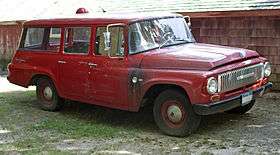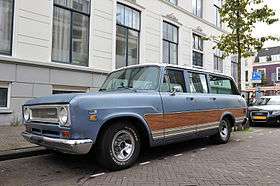International Harvester Travelall
| International Harvester Travelall | |
|---|---|
 1970s Travelall badge | |
| Overview | |
| Manufacturer | International Harvester |
| Also called | Travelall |
| Production | 1953-1975 |
| Body and chassis | |
| Class | Full-size SUV |
| Layout | |
| Body style(s) | 3/4/5-door wagon/SUV |
| Chronology | |
| Predecessor | International K/KB wagon |
| Successor | none |
The International Harvester Travelall is a full-size, truck-based sport utility vehicle that was manufactured by International Harvester from 1953 to 1975. With a layout similar to the Chevrolet Suburban, it is a precursor to the modern full-size SUV.
Background
International Harvester introduced a new line of trucks, the R Series, in 1953. Included was the 115-inch-wheelbase Travelall, a panel truck equipped with side windows and either two or three rows of passenger seats. Side-opening "barn" style cargo doors were standard, with a tailgate available as an option.
A Travelall name badge was mounted on the front cowl directly below the International name badge. A few L-Series trucks were also produced with windows and seats in 1952, but whether the Travelall name was used that year is unknown. Prior to 1952, International station wagon type vehicles were mainly woodies, having wooden bodies produced by outside companies. A few K-Series panels in the latter 1940s were built with windows and seats and used by airlines to move people at airports. The Travelall name continued to be used for station wagon versions of the succeeding S-line, A-line, and B-line pickup trucks.
First generation (1953-1957)
| First generation (R/S Series) | |
|---|---|
|
1954 R-110 Travelall in The Netherlands | |
| Overview | |
| Manufacturer | International Harvester |
| Model years | 1953-1957 |
| Body and chassis | |
| Class | Full-size SUV |
| Body style | 3-door wagon |
| Related | IHC R/S Series |
| Powertrain | |
| Engine | International Harvester 220 cu in (3.6 L) Silver Diamond inline-6 |
| Dimensions | |
| Wheelbase | 115.0 in (2,921.0 mm) |
The 1953 through 1957 Travelalls (R and S-series) had two passenger doors. The S-series was available as the S-110 or heavier duty S-120, which was also available with four-wheel drive. All shared the same 115 inches (2,921 mm) wheelbase and 131 hp (98 kW) inline-six engine.[1] Access to the rear seats in the two-door Travelalls was gained by flipping up the passenger side of the front seat. Four-wheel drive was available as an option on Travelalls beginning in 1956.
Second generation (1958-1960)
| Second generation (A/B Series) | |
|---|---|
 1959-1960 B120 Travelall | |
| Overview | |
| Manufacturer | International Harvester |
| Model years | 1958-1960 |
| Body and chassis | |
| Class | Full-size SUV |
| Body style | 4-door wagon |
| Related | IHC A/B Series |
| Powertrain | |
| Engine |
|
| Dimensions | |
| Wheelbase | 115.0 in (2,921.0 mm) |
| Length | 202.4 in (5,140 mm) (A-series)[2] |
Introduced in 1957 for the 1958 model year, the A-series (for "Anniversary", marking fifty years of International Harvester truck production) offered a 2nd passenger side door for improved access to the rear seats. Models A-100, 110, and 120 came with 113 to 154 hp (84 to 115 kW) six-cylinder engines, with four-wheel drive optional on the A-120.[2] The design changes paralleled those of the A-series pickups. The lightly modified B-series appeared in 1959 and ran just through 1960.
Third generation (1961-1968)
| Third generation (C/D Series) | |
|---|---|
 1965 D1100 Travelall | |
| Overview | |
| Manufacturer | International Harvester |
| Model years | 1961-1968 |
| Designer | Ted Ornas |
| Body and chassis | |
| Class | Full-size SUV |
| Body style | 5-door wagon |
| Related | IHC C/D Series |
| Powertrain | |
| Engine | BG 241 Inline 6, BG 265 Inline 6, 266 cu V8, 304 cu V8, 345 cu V8 |
| Dimensions | |
| Wheelbase | 119.0 in (3,022.6 mm) |
| Chronology | |
| Predecessor | B series Travelall 1959-1960 |
| Successor | D Series Travelall 1969-1975 |

In April 1961 the Travelall underwent the same changes as the pickup range upon which it was based. The new C-series Travelall benefitted from a whole new chassis with all new independent front torsion bar suspension.[3] Aside from the lower body, the most obvious visual difference were that the twin headlights were now mounted side-by-side, and a new grille of a concave egg-crate design. The wheelbase for the C-100/C-110 Travelall went up to 119 inches,[4] as the front wheels were mounted further forward. This adjustment increased the front clearance angle in spite of the lower body.[5]
This series was available either with a flip-down tailgate or two doors. The fold down gate had a window which wound down electrically. Development continued in a gradual fashion, becoming the D-series in 1965. A steady stream of new grilles and headlight treatments set the model years apart until a more thorough makeover took place in 1969. Until this model change, the Travelall had been considered merely a version of the related pickup truck; after the facelift the Travelall became a separate series.
Fourth generation (1969-1975)
| Fourth generation | |
|---|---|
 1971 Travelall 1010 | |
| Overview | |
| Manufacturer | International Harvester |
| Model years | 1969-1975 |
| Body and chassis | |
| Class | Full-size SUV |
| Powertrain | |
| Engine |
AMC 232 cu in (3.8 L) inline-six[6] International Harvester 392 cu in (6.4 L) V8 |
| Transmission |
3-speed manual 4-speed manual 5-speed manual 5-speed overdrive manual 3-speed automatic |
| Dimensions | |
| Wheelbase | 119 in (3,022.6 mm) |
| Length | 203.9 in (5,179.1 mm) |
| Width | 77.6 in (1,971.0 mm) |
| Height |
1010: 66.5 in (1,690 mm) 1110: 68.9 in (1,750 mm) |
| Curb weight |
1010: 4,251 lb (1,928 kg) 1110: 4,231 lb (1,919 kg) |

The Travelall (along with the 1000 D-series pickups on which it was based) was last redesigned in the first half of 1969 with a more modern look which echoed that of the smaller Scout. Available engine options for the 1000, 1100, and 1200 D-series Travelalls ranged from the unusual 232 ci AMC inline-six via three IHC V8s (of 304, 345, and 392 cubic inches) and four-wheel drive was optional on the 1100 and 1200s.[6] Power outputs ranged from 145 to 253 hp (108 to 189 kW). In 1973 and 1974, due to a short supply of IHC's own V8s, AMC's 401 cubic inch V8 was available as an option called the V-400. The slow-selling six-cylinder was dropped for 1972, and by 1975 only IHC's own V8s were still available, with outputs down to 141–172 hp (105–128 kW).[7] A Bendix anti-lock brake system called Adaptive Braking System, operating only on the rear wheels, was available on later Travelalls and pickups (introduced in late 1971).[8] Due to the expense of the novel system, it was a rarely selected option.
In spite of very high owner loyalty and satisfaction,[9] sales steadily declined and production of passenger pickups and Travelalls ended entirely in May, 1975; production of the Scout continued until 1980. The company exists today as Navistar International, and continues to make medium and large trucks. A two barrel carburetor version of the AMC 401 V8 (called the V-400 by IHC) was used in 1974 when International's own 392 was in short supply.
Variants
Travelalls were also produced with raised roofs and extended wheelbases for applications such as school buses, ambulances and airport limos. Many of these modifications were performed by the Springfield Equipment Company and were marketed by International.
Wagon Master
In 1973 and 1974 a modified Travelall was marketed as the International Harvester Wagon Master. The roof over the cargo section was removed to make a short pickup type bed. The target market for the Wagon Master were people who pulled fifth wheel RV trailers. The exposed cargo area provided the space needed to mount the fifth wheel for the trailer. The Wagon Master was very much like the Chevrolet Avalanche produced in the early and mid 2000's.
Popular culture
In the films Grumpy Old Men and Grumpier Old Men Max Goldman drives a 1974 Travelall.[10]
In the apocalyptic novel Lucifer's Hammer by Larry Niven and Jerry Pournelle Harvey Randall uses a Travelall extensively.[11]
Folk musician Greg Brown sings about a Travelall in his song Laughing River.[12]
References
- ↑ "Station Wagons Galore This Year: More Makes, More Models. Here Are All the Facts". Changing Times: The Kiplinger Magazine. Washington, DC. 11 (2): 19. February 1957.
- 1 2 "The 1958 Station Wagons". Changing Times: The Kiplinger Magazine. Washington, DC. 12 (2): 22. February 1958.
- ↑ Sales Engineering Bulletin: C-line Travelall (PDF), International Harvester Company, April 1961, p. 10, CT-477
- ↑ Sales Engineering Bulletin: C-line Travelall, p. 3
- ↑ Sales Engineering Bulletin: C-line Travelall, p. 8
- 1 2 Lamm, Michael (May 1971). "She's no beauty, but owners say, "Look beneath the skin!"". Popular Mechanics. NY, NY: The Hearst Corporation. 135 (5): 135.
- ↑ '75 International Recreational Vehicles, International Harvester, 1974, p. 12, AD-40333-C1
- ↑ Lund, Robert (February 1971). "Detroit Listening Post". Popular Mechanics. NY, NY: The Hearst Corporation. 135 (2): 46H, 48.
- ↑ Lamm (May 1971), p. 132. 92.4% of owners questioned said that they would buy another Travelall.
- ↑ http://www.athensbooksblog.com/the-vehicles-of-grumpy-and-grumpier-old-men/
- ↑ http://www.bookrags.com/studyguide-lucifers-hammer/chapanal004.html#gsc.tab=0
- ↑ http://www.oldielyrics.com/lyrics/greg_brown/laughing_river.html
| Wikimedia Commons has media related to International Harvester Travelall. |